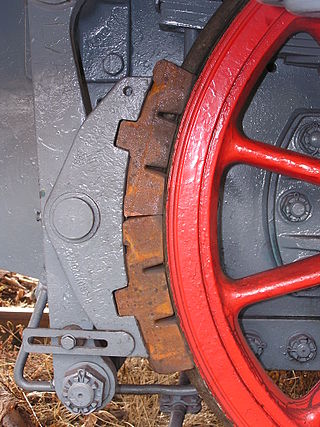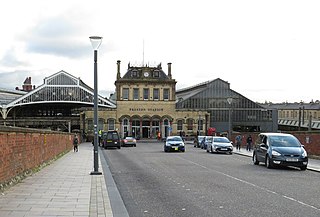Related Research Articles
The Armagh rail disaster happened on 12 June 1889 near Armagh, County Armagh, in Ireland, when a crowded Sunday school excursion train had to negotiate a steep incline; the steam locomotive was unable to complete the climb and the train stalled. The train crew decided to divide the train and take forward the front portion, leaving the rear portion on the running line. The rear portion was inadequately braked and ran back down the gradient, colliding with a following train.

The Abergele rail disaster took place near Abergele, North Wales, in August 1868. At the time, it was the worst railway disaster to have occurred in Great Britain.

A railway brake is a type of brake used on the cars of railway trains to enable deceleration, control acceleration (downhill) or to keep them immobile when parked. While the basic principle is similar to that on road vehicle usage, operational features are more complex because of the need to control multiple linked carriages and to be effective on vehicles left without a prime mover. Clasp brakes are one type of brakes historically used on trains.

Preston railway station, in Preston, Lancashire, England, is an interchange on the West Coast Main Line; it is approximately half-way between London Euston and Glasgow Central. It is served by Avanti West Coast, Northern Trains and TransPennine Express services, plus Caledonian Sleeper overnight services between London and Scotland. It is also served by the Calder Valley line to Leeds and York, and by branch lines to Blackpool North, Ormskirk and Colne.

Catch points and trap points are types of points which act as railway safety devices. Both work by guiding railway carriages and trucks from a dangerous route onto a separate, safer track. Catch points are used to derail vehicles which are out of control on steep slopes. Trap points are used to protect main railway lines from unauthorised vehicles, moving onto them from sidings or branch lines. Either of these track arrangements may lead the vehicles into a sand drag or safety siding, track arrangements which are used to safely stop them after they have left the main tracks.

John Axon GC was an English train driver from Stockport who died while trying to stop a runaway freight train on a 1 in 58 gradient at Chapel-en-le-Frith in Derbyshire after a brake failure. The train consisted of an ex-LMS Stanier Class 8F 2-8-0 No. 48188 hauling 33 wagons and a brake van.

Over the latter years of the 19th and early years of the 20th centuries, Penistone in Yorkshire gained a name as an accident black-spot on Britain's railway network; indeed, it could be said to hold the title of the worst accident black-spot in the country. The main line through the town was the Woodhead route of the Manchester, Sheffield and Lincolnshire Railway between Sheffield Victoria and Manchester, London Road. The line was heavily graded with a summit some 400 yards inside the eastern portal of the Woodhead tunnel.

Torquay railway station is on the Riviera Line and serves the seaside resort of Torquay, Devon, England. It is 219 miles 79 chains (354 km) from London Paddington.

The Thirsk rail crash occurred on 31 July 1967 at Thirsk, Yorkshire, England on the British Rail East Coast Main Line.

Stairfoot railway station was a railway station on the South Yorkshire Railway's main line between Mexborough and Barnsley. It was situated between Wombwell Central and Barnsley. The station was intended to serve the communities of Ardsley and Stairfoot, South Yorkshire, England.
The Murulla rail accident involved the collision of the Sydney-bound Northern Mail with runaway goods wagons near Murrurundi, in the Upper Hunter Valley on 13 September 1926; 26 persons died. A goods train had become divided and the attempts of the train crew to reunite the portions resulted in 12 vehicles running away down a steep gradient, and colliding with the approaching mail train. This was the worst accident on the New South Wales rail network until the Granville railway disaster in 1977.
There have been a number of train accidents on the railway network of Victoria, Australia. Some of these are listed below.
The railways of New South Wales, Australia have had many incidents and accidents since their formation in 1831. There are close to 1000 names associated with rail-related deaths in NSW on the walls of the Australian Railway Monument in Werris Creek. Those killed were all employees of various NSW railways. The details below include deaths of employees and the general public.
The Coton Hill rail crash was a train crash which occurred on 11 January 1965, at Coton Hill, near Shrewsbury in Shropshire, England.
The Rednal rail crash was a rail accident that occurred near Rednal station in Shropshire.
The Wetheral train accident occurred in England at about 4 p. m. on Saturday 3 December 1836 when a passenger train on the Newcastle and Carlisle Railway was wrongly diverted into a siding at Wetheral, a village close to Carlisle, Cumbria. The train derailed and crushed three people to death.
The Welwyn Tunnel rail crash took place in Welwyn North Tunnel, north of Welwyn station on the Great Northern Railway, on 9 June 1866. According to L T C Rolt, "from the point of view of damage to engines and rolling stock it was one of the most destructive in railway history."
Col. Frederick Henry Rich was a British soldier, who served with the Royal Engineers and was the Chief Inspecting Officer of the Railway Inspectorate between 1885 and 1889. He investigated many of the major railway accidents in the late 19th century, including those at Staplehurst in 1865, in which the author Charles Dickens was involved, and at Norton Fitzwarren in 1890.
The Browney train crash occurred near to the Browney signal box on the East Coast Main Line, County Durham, England on 5 January 1946. A southbound goods train split in two, with the rear portion accelerating downhill and crashing into the front portion of the train, which had been stopped by the signaller to inform the driver that the train was split into two. The wreckage of the goods train was then hit by an express train heading north from London King's Cross, killing ten people and seriously wounding 18 others.
References
- ↑ "Accident Returns: Extract for Accident at Stairfoot on 12th December 1870". www.railwaysarchive.co.uk. Retrieved 1 February 2015.